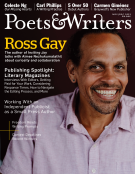In her second poetry collection, In the Current Where Drowning Is Beautiful (Wesleyan University Press, November 2022), Abigail Chabitnoy offers what she describes as a “lyrical revisioning of violence against Indigenous women and the resilience of such women in the face of that violence.” In poems structured like waves, with recurring phrases and lines eddying across the page, Chabitnoy links the treatment of Indigenous women in the United States with harm toward migrants and the environment. The book is an act of unburying in which Chabitnoy refuses to let the government or media paper over this history. Chabitnoy, who is a Koniag descendant and member of the Tangirnaq Native Village in Kodiak, Alaska, shifts between English and Alutiiq in the poems, embracing the “untethered place” of longing and liminality.

Top: Abigail Chabitnoy, author of In the Current Where Drowning Is Beautiful. (Credit: Daniel Kerstetter)
In the two years Chabitnoy spent writing the book—in addition to two years of “meandering not-writing, which is in fact so valuable,” she says—she found that publishing in journals pushed her to “consider the larger conversations I want my work to engage in.” She placed some of the earliest poems from In the Current Where Drowning Is Beautiful in Peripheries as part of a folio of Indigenous poetry edited by Joan Naviyuk Kane. At the time, Chabitnoy didn’t see the poems as part of a coherent project. After reading her work, however, alongside poets such as Michaelsun Knapp and Monique Sanchez, she glimpsed a through-line for her book. Established in 2017 and published by Harvard Divinity School’s Center for the Study of World Religions, this annual journal, published in both print and digital editions, seeks work that explores “the tangential, the borderline, and particularly the metaxical spaces (that both attract and repel) between artistry, philosophical speculation, mystical experience, and religious traditions.” Peripheries features art, poetry, fiction, nonfiction, and experimental texts; the latest issue showcased writers such as Robin Coste Lewis, Fred Moten, Kay Ryan, and Terry Tempest Williams. Submissions are open via e-mail.
After the Massachusetts Review included her poem “Girls Are Coming Out of the Water” in an issue titled “A Gathering of Native Voices,” Chabitnoy more clearly saw her work as contending with “Indigenous survival and questions of who is telling the (hi)stories.” Guest edited by Tacey M. Atsitty, Laura Furlan, and Toni Jensen, the 2020 issue convened more than thirty artists and writers, highlighting the many ways Indigenous communities fight for sovereignty and protection of their rights, lands, and waters. The political aims of that issue align with the print quarterly’s larger goal to promote social justice and equality. In print since 1959, the journal publishes original and translated poetry, fiction, essays, and art. Edited at the University of Massachusetts in Amherst, the journal also features book reviews and interviews online and publishes “Working Titles,” a digital series of long prose pieces. Submissions are currently open.
After hearing Chabitnoy read at the launch for the Massachusetts Review’s “A Gathering of Native Voices” issue, an editor from Grub Street solicited her work. Drawn to the annual’s openness to visual work, Chabitnoy published several poems and linocut pieces in Grub Street, which offers a digital edition of each print issue as well as selections online. Edited by undergraduates at Towson University in Maryland, the magazine circulates poems, stories, essays, and art. Grub Street takes its name from the famed thoroughfare of seventeenth- and eighteenth-century London, which nurtured the field of magazine publishing despite being scorned for its “writers of small histories, dictionaries, and temporary poems,” as Samuel Johnson wrote in 1755. Submissions are open via Submittable.
Chabitnoy notes it can be hard to balance writing and reading poetry and the time it takes to submit work; she ended up publishing several other poems from In the Current Where Drowning Is Beautiful after connecting with writers and editors. For example, she sent poems to the Capilano Review on the invitation of Jordan Abel, a poet and Capilano editorial board member whom Chabitnoy met at a symposium on water and poetry at Columbia University in 2020. The Capilano Review, which this year celebrates its fiftieth anniversary, publishes poetry, fiction, nonfiction, and art three times a year online and in print. Edited in Vancouver, British Columbia, the review also hosts contests, workshops, readings, and an annual writer-in-residence. As of this writing, submissions are closed.
Throughout her collection, Chabitnoy weaves in lines in Alutiiq—a decision that she notes was bolstered by first publishing poems in Alutiiq and English in Ariel, a semiannual print and online journal devoted to art and multilingual poetry and prose. A recent issue included an essay on the love affair between Russian poets Marina Tsvetaeva and Sophia Parnok, an interview with a German writer and art historian, and poems in Ukrainian, French, Hebrew, Spanish, and Macedonian. Edited in Würzburg, Germany, Ariel also publishes book reviews. Submissions are open year-round via e-mail.
Dana Isokawa is the managing editor of the Margins and a contributing editor of Poets & Writers Magazine.









